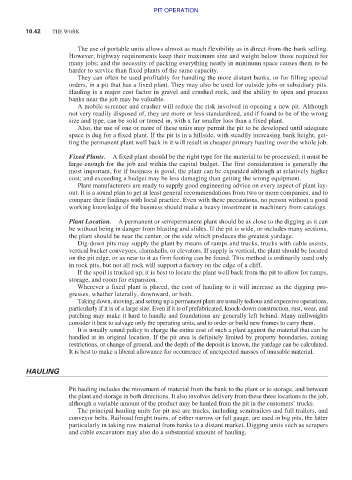Page 536 - Moving the Earth_ The Workbook of Excavation
P. 536
PIT OPERATION
10.42 THE WORK
The use of portable units allows almost as much flexibility as in direct-from-the-bank selling.
However, highway requirements keep their maximum size and weight below those required for
many jobs; and the necessity of packing everything neatly in minimum space causes them to be
harder to service than fixed plants of the same capacity.
They can often be used profitably for handling the more distant banks, or for filling special
orders, in a pit that has a fixed plant. They may also be used for outside jobs or subsidiary pits.
Hauling is a major cost factor in gravel and crushed rock, and the ability to open and process
banks near the job may be valuable.
A mobile screener and crusher will reduce the risk involved in opening a new pit. Although
not very readily disposed of, they are more or less standardized, and if found to be of the wrong
size and type, can be sold or turned in, with a far smaller loss than a fixed plant.
Also, the use of one or more of these units may permit the pit to be developed until adequate
space is dug for a fixed plant. If the pit is in a hillside, with steadily increasing bank height, get-
ting the permanent plant well back in it will result in cheaper primary hauling over the whole job.
Fixed Plants. A fixed plant should be the right type for the material to be processed; it must be
large enough for the job and within the capital budget. The first consideration is generally the
most important, for if business is good, the plant can be expanded although at relatively higher
cost; and exceeding a budget may be less damaging than getting the wrong equipment.
Plant manufacturers are ready to supply good engineering advice on every aspect of plant lay-
out. It is a sound plan to get at least general recommendations from two or more companies, and to
compare their findings with local practice. Even with these precautions, no person without a good
working knowledge of the business should make a heavy investment in machinery from catalogs.
Plant Location. A permanent or semipermanent plant should be as close to the digging as it can
be without being in danger from blasting and slides. If the pit is wide, or includes many sections,
the plant should be near the center, or the side which produces the greatest yardage.
Dig-down pits may supply the plant by means of ramps and trucks, trucks with cable assists,
vertical bucket conveyors, clamshells, or elevators. If supply is vertical, the plant should be located
on the pit edge, or as near to it as firm footing can be found. This method is ordinarily used only
in rock pits, but not all rock will support a factory on the edge of a cliff.
If the spoil is trucked up, it is best to locate the plant well back from the pit to allow for ramps,
storage, and room for expansion.
Wherever a fixed plant is placed, the cost of hauling to it will increase as the digging pro-
gresses, whether laterally, downward, or both.
Taking down, moving, and setting up a permanent plant are usually tedious and expensive operations,
particularly if it is of a large size. Even if it is of prefabricated, knock-down construction, rust, wear, and
patching may make it hard to handle and foundations are generally left behind. Many millwrights
consider it best to salvage only the operating units, and to order or build new frames to carry them.
It is usually sound policy to charge the entire cost of such a plant against the material that can be
handled at its original location. If the pit area is definitely limited by property boundaries, zoning
restrictions, or change of ground, and the depth of the deposit is known, the yardage can be calculated.
It is best to make a liberal allowance for occurrence of unexpected masses of unusable material.
HAULING
Pit hauling includes the movement of material from the bank to the plant or to storage, and between
the plant and storage in both directions. It also involves delivery from these three locations to the job,
although a variable amount of the product may be hauled from the pit in the customers’ trucks.
The principal hauling units for pit use are trucks, including semitrailers and full trailers, and
conveyor belts. Railroad freight trains, of either narrow or full gauge, are used in big pits, the latter
particularly in taking raw material from banks to a distant market. Digging units such as scrapers
and cable excavators may also do a substantial amount of hauling.

